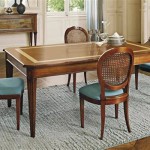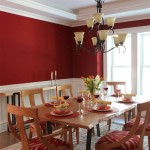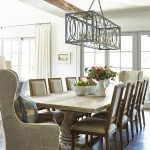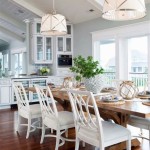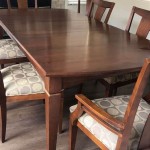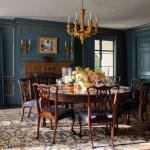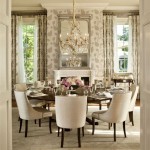Dining Room Furniture For Small Rooms
Creating a functional and aesthetically pleasing dining area in a small room presents a unique set of challenges. Space is at a premium, and selecting the right dining room furniture becomes crucial for maximizing usability and minimizing clutter. This article will explore various furniture options, design strategies, and considerations for creating a comfortable and stylish dining experience even in limited square footage. The goal is to analyze how to choose furniture that not only fits physically but also enhances the overall ambiance of the room.
The primary objective when furnishing a small dining room is optimization. Every piece of furniture should serve a purpose and contribute to the room's functionality without overwhelming the space. Careful planning and consideration of dimensions are essential before making any purchases. Understanding the trade-offs between different furniture styles is also critical. For instance, maximizing seating capacity might necessitate compromising on the overall size of the table or choosing seating options that can be easily stored when not in use.
Before delving into specific furniture pieces, it is important to assess the existing space accurately. Measure the room's dimensions carefully, noting the location of doorways, windows, and any architectural features that might impact furniture placement. Consider the room's layout and how it connects to other areas of the house. This initial assessment will provide a foundation for making informed decisions about furniture size, shape, and style.
The color palette of the dining room also plays a significant role in creating a sense of spaciousness. Lighter colors tend to reflect more light, making the room feel brighter and airier. Opting for light-colored walls, flooring, and furniture can significantly enhance the perception of space. Conversely, darker colors can make a small room feel even smaller and more cramped. Neutral tones, such as whites, creams, and grays, are generally good choices for small dining rooms.
Selecting the Right Dining Table
The dining table is undoubtedly the focal point of any dining room. In a small room, choosing the right table size and shape is paramount. A large, rectangular table can quickly dominate a small space, making it feel crowded and uncomfortable. Therefore, it is essential to consider alternative table shapes and sizes that are better suited for limited square footage.
Round tables are often an excellent choice for small dining rooms. Their circular shape allows for easier traffic flow around the table and can accommodate more people in a smaller area compared to a rectangular table of the same surface area. Round tables also promote a more intimate and conversational dining experience. When selecting a round table, consider the diameter carefully to ensure it is not too large for the room.
Square tables are another viable option for small dining rooms, especially if the room itself is square or has a more compact layout. Square tables provide a balanced and symmetrical aesthetic. However, they may not be as space-efficient as round tables in terms of accommodating a larger number of diners. If choosing a square table, ensure that it is not excessively large, as it can create visual clutter.
Drop-leaf tables and extendable tables offer a flexible solution for small dining rooms. These tables can be adjusted in size to accommodate different needs. When not in use, the leaves can be folded down or the table can be collapsed to save space. When guests are over, the table can be extended to provide additional seating. This versatility makes drop-leaf and extendable tables ideal for small spaces where flexibility is essential.
Another factor to consider is the table's base. Pedestal tables, which have a single central support, can often feel less bulky than tables with four legs. They also allow for more legroom and easier seating arrangements. Tables with slim, minimalist legs can also help to create a more open and airy feel in the room. Avoid tables with heavy, ornate legs, as they can visually weigh down the space.
Material choice also impacts the perceived size and weight of the table. Glass-top tables can create the illusion of more space due to their transparency. They allow light to pass through, making the room feel brighter and less cluttered. However, glass can be more fragile and require more maintenance. Wooden tables are a classic choice, but opt for lighter wood tones to avoid making the room feel too dark. Tables with metal frames can also add a touch of modern elegance and lightness to the space.
Selecting the Right Chairs
Choosing the right chairs is just as important as selecting the right table. Chairs occupy significant visual space in a dining room, and their style, size, and arrangement can greatly impact the overall feel of the room. Opt for chairs that are comfortable, functional, and visually appealing without overwhelming the space.
Smaller chairs are generally better suited for small dining rooms. Chairs with a lower back height can create a more open and airy feel. Armless chairs are also often preferable, as they take up less space and can be easily tucked under the table when not in use. If armrests are desired, consider chairs with sleek, minimalist armrests that do not add excessive bulk.
Clear acrylic chairs, also known as ghost chairs, are an excellent option for small dining rooms. Their transparent design allows them to blend seamlessly into the background, creating the illusion of more space. They are also surprisingly comfortable and durable. Acrylic chairs are available in a variety of styles and can add a touch of modern sophistication to the dining room.
Folding chairs provide a practical and space-saving solution for occasional seating. When not in use, they can be easily folded up and stored away, freeing up valuable floor space. Folding chairs are available in a wide range of styles and materials, making it easy to find options that complement the room's décor. They are particularly useful for small apartments or homes with limited storage space.
Benches can be a versatile seating option for small dining rooms. They can accommodate more people than individual chairs and can be easily tucked under the table when not in use. Benches are particularly well-suited for informal dining settings and can add a touch of rustic charm to the room. Consider benches with built-in storage to maximize functionality and minimize clutter.
Upholstered chairs can add comfort and style to the dining room, but be mindful of the fabric and color. Lighter-colored upholstery can help to make the room feel brighter and more spacious. Choose durable and easy-to-clean fabrics to ensure that the chairs remain in good condition for years to come. Avoid overly ornate or bulky upholstery, as it can visually weigh down the space.
The style of the chairs should complement the style of the table. A modern table pairs well with sleek, minimalist chairs, while a more traditional table might be better suited for chairs with classic lines and detailing. Consider the overall aesthetic of the room and choose chairs that enhance the existing décor.
Storage Solutions and Accessories
In addition to the table and chairs, storage and accessories play a vital role in creating a functional and stylish dining room. In a small room, it is essential to choose storage solutions that are space-saving and efficient. Accessories should be carefully selected to enhance the room's aesthetic without adding unnecessary clutter.
Wall-mounted shelves and cabinets are an excellent way to maximize storage space in a small dining room. They take advantage of vertical space, freeing up valuable floor space. Wall-mounted shelves can be used to display decorative items, store dinnerware, or hold books. Wall-mounted cabinets provide concealed storage for items that you want to keep out of sight.
Corner cabinets are another space-saving storage solution for small dining rooms. They fit snugly into corners, utilizing often-underutilized space. Corner cabinets can be used to store dishes, silverware, or linens. Choose corner cabinets with glass doors to display your favorite items or solid doors to conceal clutter.
Buffets and sideboards can provide ample storage space for dishes, serving pieces, and linens. However, they can also take up a significant amount of floor space. If choosing a buffet or sideboard, opt for a smaller, more streamlined model that does not overwhelm the room. Consider models with drawers and cabinets to maximize storage efficiency.
Mirrors can be used to create the illusion of more space in a small dining room. They reflect light, making the room feel brighter and airier. Place a large mirror on a wall to visually expand the room. Mirrors can also be used to create a focal point or to reflect a pleasant view.
Lighting is an essential element in any dining room. In a small room, it is particularly important to choose lighting fixtures that provide adequate illumination without taking up too much space. Recessed lighting is an excellent option for small dining rooms, as it does not require any floor or table space. A pendant light or chandelier can also add a touch of elegance and sophistication to the room, but be sure to choose a fixture that is appropriately sized for the space.
Rugs can help to define the dining area and add warmth and texture to the room. Choose a rug that is large enough to accommodate the table and chairs, but not so large that it overwhelms the space. Lighter-colored rugs can help to make the room feel brighter and more spacious.
Artwork and decorative accents can add personality and interest to the dining room, but be mindful of clutter. Choose a few carefully selected pieces that complement the room's décor and avoid overcrowding the space with too many accessories. Wall art, such as paintings or prints, can add visual interest without taking up any floor space. Plants can also bring life and freshness to the room.
By carefully selecting the right furniture, storage solutions, and accessories, it is possible to create a functional and stylish dining room even in a small space. Prioritize space-saving designs, lighter colors, and minimalist aesthetics to maximize the perception of spaciousness. Regular decluttering and organization are also essential for maintaining a comfortable and inviting dining environment.

19 Small Dining Room Ideas And Decorating Tricks For 2025

Design Tips For Small Space Dining Rooms

Design Dilemma How To Create A Dining Room In Small Space

15 Narrow Dining Tables For Small Spaces

20 Small Scandinavian Dining Rooms Dynamic Functionality With Muted Charm Decoist

Dining Room Designs For Small Spaces Designcafe

Small Dining Table Kitchen Pottery Barn

30 Small Dining Room Ideas To Make The Most Of Your Space

5 Dining Room Designs For Small Spaces Kevin Szabo Jr Plumbing Services Local Plumber Tinley Park Il

Small Dining Room Ideas And Decorating Tips Coastwood Furniture

